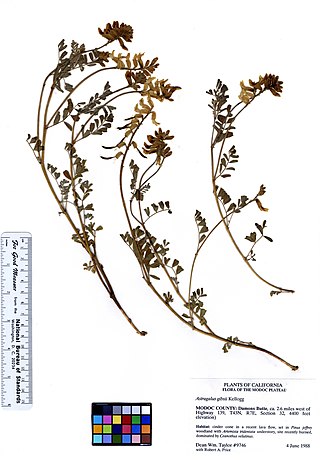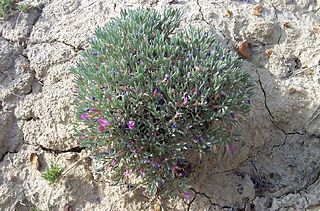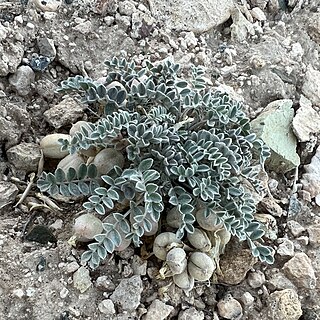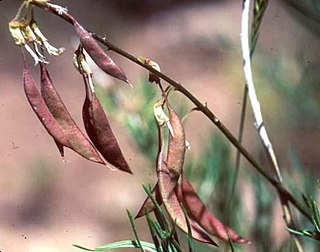
Astragalus albens is a species of milkvetch known by the common names Cushenbury milkvetch and silvery-white milkvetch.

Astragalus bernardinus, known by the common name San Bernardino milkvetch or the Lesser Three-keeled Milkvetch, is a species of milkvetch. It is a plant of desert and dry mountain slope habitat. It is native to California.

Astragalus bolanderi is a species of milkvetch known by the common name Bolander's milkvetch. It is native to western Nevada and parts of the Sierra Nevada in California. It grows in dry, rocky habitat on mountain and plateau.
Astragalus funereus is an uncommon species of milkvetch known by the common names Funeral Mountain milkvetch and black milkvetch.

Astragalus gibbsii is a species of milkvetch known by the common name Gibbs's milkvetch. It is native to eastern California, the north-central Sierra Nevada, and western Nevada, where it grows in the pine forest habitat of the mountains and the sagebrush of the plateaus.

Astragalus kentrophyta is a species of milkvetch known by the common name spiny milkvetch. It is native to western North America from central to west Canada, to California, to New Mexico. It grows in rocky mountainous areas, such as the Sierra Nevada, and on plateaus.

Astragalus purshii is a species of milkvetch known by the common names woollypod milkvetch and Pursh's milkvetch.

Astragalus desereticus is a rare species of milkvetch known by the common name Deseret milkvetch. It is endemic to Utah County, Utah, where it is known from only one population. It was thought to be extinct until 1981 when this population was discovered. The population contains 5,000 to 10,000 plants on an area of land covering less than 300 acres. It is vulnerable to damage from grazing cattle, which eat the plant and trample the soil, and from development and erosion. This is a federally listed threatened species.

Astragalus limnocharis var. montii, synonym Astragalus montii, is a rare variety of flowering plant in the legume family. It is known by the common name Monti's milkvetch. It is endemic to Utah in the United States, where there are only three known populations. Under the synonym A. montii, it is a federally listed threatened species of the United States.

Astragalus iselyi is a rare species of flowering plant in the legume family known by the common name Isely's milkvetch. It is endemic to Utah in the United States.

Astragalus australis is a species of flowering plant in the legume family known by the common name Indian milkvetch. It is native to much of the Northern Hemisphere, including northern North America, Europe, and temperate Asia.

Astragalus barrii is a species of flowering plant in the legume family known by the common name Barr's milkvetch. It is native to the United States, where it is a "regional endemic", occurring in parts of southwestern South Dakota, northeastern Wyoming, southeastern Montana, and Nebraska.

Astragalus mulfordiae is a species of flowering plant in the legume family known by the common name Mulford's milkvetch. It was so named after its discoverer Anna Isabel Mulford. It is native to the Snake River Plain in Idaho and Oregon in the United States.
Astragalus sinuatus is a species of flowering plant in the legume family known by the common name Whited's milkvetch. It is endemic to Washington in the United States, where it is limited to one creek drainage on the western edge of the Columbia Basin. Its range measures about ten square miles in Chelan and Kittitas Counties in the central part of the state.
Astragalus tyghensis is a species of flowering plant in the legume family known by the common name Tygh Valley milkvetch. It is endemic to Oregon in the United States, where it is known only from the Tygh Valley of Wasco County.

Astragalus anisus is a species of flowering plant in the legume family known by the common name Gunnison milkvetch. It is endemic to Colorado in the United States, where it is limited to the Gunnison Basin of Gunnison and Saguache Counties.

Astragalus molybdenus is a species of flowering plant in the legume family known by the common names Leadville milkvetch and molybdenum milkvetch. It is endemic to Colorado in the United States. If the separate species Astragalus shultziorum and Astragalus lackschewitzii are included in A. molybdenum the range expands into Wyoming and Montana.
Astragalus proximus is a species of flowering plant in the legume family known by the common name Aztec milkvetch. It is native to southern Colorado and northern New Mexico in the United States.

Astragalus ripleyi is a species of flowering plant in the legume family known by the common name Ripley's milkvetch. It is native to southern Colorado and northern New Mexico in the United States.
Astragalus wetherillii is a species of flowering plant in the legume family known by the common name Wetherill's milkvetch. It is native to Colorado and Utah in the United States.















